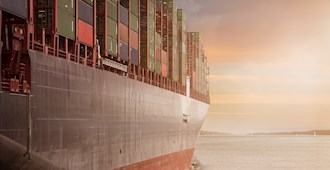The Future of Logistics: Trends for 2024
Date: 01/02/2024
As we approach 2024, the world of logistics is on the cusp of transformation. Uncover the latest logistics trends to look out for in our latest blog.
As we approach 2024, the world of logistics is on the cusp of transformation. This upcoming year is poised to witness significant advancements across various facets of the industry. This transformation is not just about redefining how we move goods but also about revolutionising the intricate web of supply chain management and addressing emerging challenges.
In this blog, we will explore the most notable predictions and logistics trends that are set to shape the landscape in the near future. From the integration of advanced robotics to an intensified focus on sustainability and the ever-pressing concerns of cybersecurity, these developments promise to alter the transport and logistics industry, paving the way for a robust and innovative future.
Digitalization: Transforming the Shipping Industry
The shipping and logistics industry has been inching towards digitalization for some time, but in 2024, it will become a reality for many. The COVID-19 pandemic and the shift to remote work expedited the digitalization process, leading some shipping companies to venture into digital solutions.
As one of the key supply chain trends of 2024, Artificial Intelligence (AI) and blockchain technology are at the forefront of this evolution, playing a key role in optimising routes, streamlining operations, and enhancing predictive analytics. Complementing this, blockchain technology will ensure secure, transparent tracking from manufacturer to consumer, thus vastly improving supply chain visibility.
This digitalization is an extension of existing software systems in the industry. The result will be a dynamic, data-driven, and highly efficient shipping ecosystem in the near future. Businesses and consumers stand to reap substantial benefits from these technological advancements.
Advanced Robotics: Revolutionising Warehouses
Smart warehousing is at the forefront of an industrial revolution and is an essential logistics trend to look out for. This involves integrating AI, IoT devices, and robotics to redefine operations. This technological fusion promises remarkable improvements in various aspects of warehouse operations, including enhanced inventory management, more efficient picking, packing, and streamlined shipping processes. That transition towards smarter warehousing not only minimises the reliance on manual labour but also substantially reduces errors and lead times.
The Rise of Blockchain
The freight forwarding industry is actively seeking innovations to enhance transparency and trust within the supply chain, and blockchain is emerging as a catalyst for transformative change. Companies within the industry are ready to adopt blockchain technology for multifaceted purposes – authenticating product origins, streamlining complex transactions, and fortifying defences against fraud. Consequently, this cutting-edge technology will establish secure, tamper-proof transaction records, effectively reducing the dependence on intermediaries.
Last-Mile Delivery Solutions
The significance of last-mile delivery has surged dramatically, driven by the exponential growth of e-commerce sales. Meeting the escalating need for swift and cost-effective delivery, logistics companies are shifting towards embracing groundbreaking solutions. Essential supply chain trends include the integration of micro-fulfillment centres, the utilisation of delivery robots, and the deployment of autonomous delivery vehicles. These strategic breakthroughs are designed to optimise the final leg of the delivery process, ensuring that products reach the end customer with remarkable speed, efficiency, and affordability.
Fast and Futuristic Deliveries
The need for rapid deliveries has set the stage for drone delivery, autonomous vehicles, and localised fulfilment centres to transform the logistics landscape. As customer expectations for swift delivery rise, we can expect exciting progress in this field. Drones and autonomous vehicles are positioned to play a pivotal role in meeting these evolving demands for speedy and efficient deliveries, marking a significant turning point in the industry.
Simulating Success
Digital twins are virtual replicas of physical systems that enable businesses to explore, evaluate, and fine-tune various scenarios, all within a virtual realm, thus empowering them to resolve issues and optimise operations before implementing real-world changes.
The integration of this technology is set to offer a multifaceted advantage, from improving overall efficacy to significantly curbing expensive errors in various facets of logistics operations, thereby fostering a smarter and more agile logistics ecosystem.
Building Resilient Supply Chains
The global supply chain faced unprecedented challenges during the COVID-19 pandemic, revealing its vulnerabilities. In response, businesses are rethinking their supply chain strategies, with a primary focus on bolstering resilience and risk management. This strategic shift encompasses the diversification of supplier networks, the recalibration of sourcing strategies, and the meticulous development of contingency plans.
Additionally, the implementation of advanced analytics emerges as a vital tool in the process, enabling the identification of potential risks and the formulation of well-tailored responses to ensure continuity in the face of unforeseen disruptions.
Cybersecurity: Protecting Digital Assets
As the logistics network embraces digitalization, cybersecurity becomes paramount. In 2024, it is likely that the entire shipping industry, along with its partners, will heavily invest in cybersecurity. Protecting sensitive data, safeguarding cargo from theft, and preventing cyberattacks that disrupt operations are top priorities. Expect multifactor authentication to become the standard in shipping and logistics, as it is in other industries.
Sustainability: A Growing Imperative
Sustainability and environmentally friendly practices have been discussed for years, but the shipping and logistics industry in the Middle East is now making strong efforts to be more environmentally responsible. This is partly because of the increasing frequency and costs of natural disasters caused by climate change and new rules like the IMO 2020 regulation from global shipping authorities.
It’s expected that by 2024, more ambitious sustainability measures are expected, such as optimising routes for lower fuel consumption, increasing the use of electric vehicles, and adopting circular economy principles to minimise waste.
In summary, the logistics trends discussed in this article collectively portray a logistics sector not only adjusting to current challenges but also ready to mould a more systematic, sustainable, and interconnected supply chain in 2024.
While challenges lie ahead, strategic foresight promises enhanced proficiency, reduced environmental impact, and more globalised trade and commerce. To stay updated on these dynamic changes, please visit our website at WLP.




